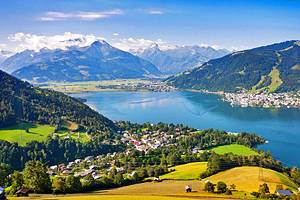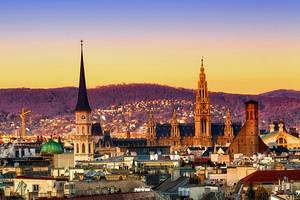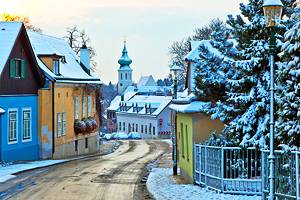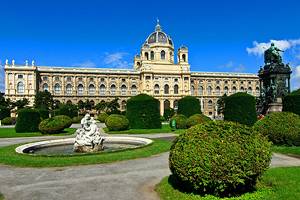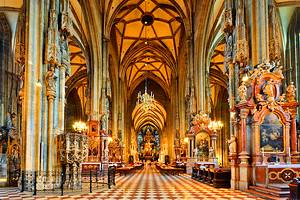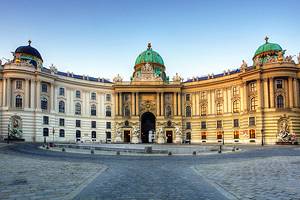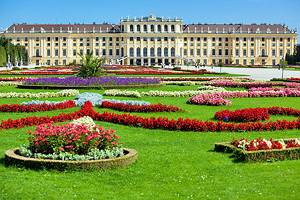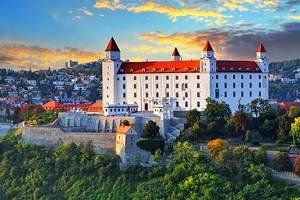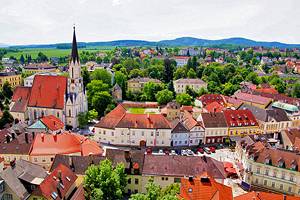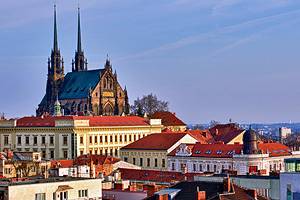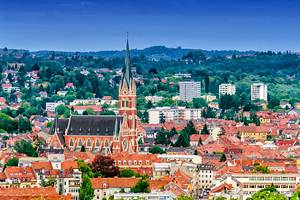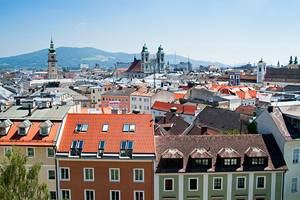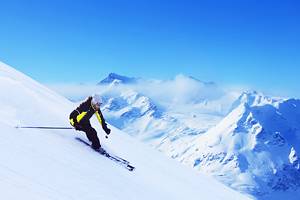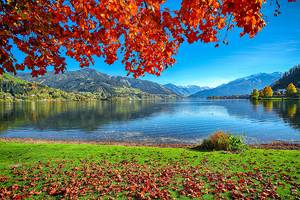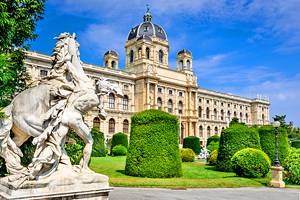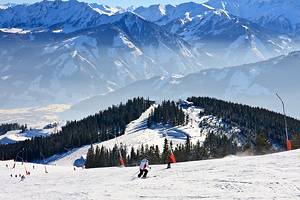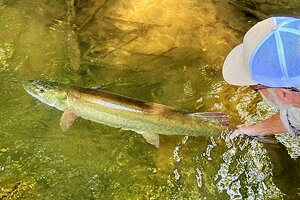Exploring Vienna's Belvedere Palace: A Visitor's Guide
Belvedere Palace (Schloss Belvedere) - or "The Belvedere," as this collection of magnificent structures has come to be known - is really two palaces in one. Undoubtedly one of Vienna's most visited tourist spots and an important historic site, this splendid attraction consists of two Baroque palaces built for Prince Eugene: the Lower (Unteres) Belvedere, and the Upper (Oberes) Belvedere.
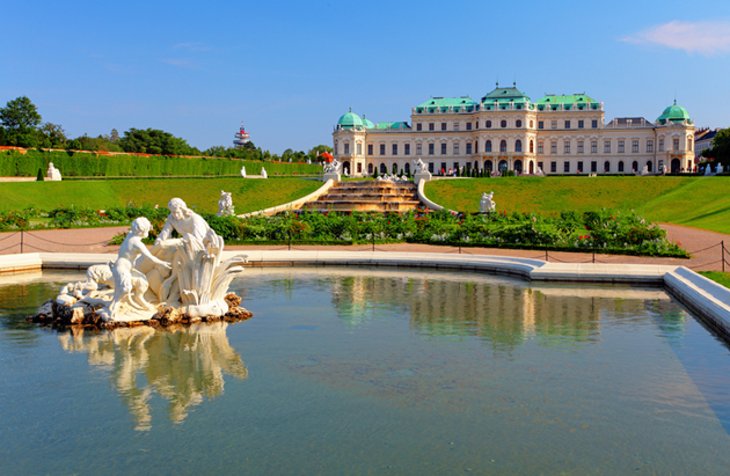
The attraction is also home to many of Austria's most important art collections. These include large collections relating to medieval art, the Austrian Baroque period, as well as Austrian art from the 19th and 20th centuries.
After years of extensive renovations, a visit to Belvedere Palace is one of the top things to do in Vienna and makes for a truly memorable vacation experience. Be sure to purchase a Combi Ticket allowing access to all areas of the complex, and if there's room in your Vienna travel itinerary, set aside a full day to properly explore this amazing site (and that's a must!).
To find out more about this top Austrian attraction, be sure to bookmark our visitor's guide to exploring Vienna's Belvedere Palace.
See also: Where to Stay near Vienna's Belvedere Palace
- The History of Belvedere Palace
- Upper Palace Highlights
- Lower Palace Highlights
- The Orangery at Belvedere
- The Palace Stables
- The Belvedere Gardens and Fountains
- The Winter Palace of Prince Eugene
- Art Galleries and Collections
- Touring Belvedere Palace
- Where to Stay near Vienna's Belvedere Palace
- Tips and Tactics: How to Make the Most of Your Visit to Belvedere Palace
- Getting to Belvedere Palace
- Address
- Vienna - Climate Chart
- What's Nearby?
The History of Belvedere Palace
With the Château of Versailles in France uppermost in mind, Prince Eugene - fresh from having defeated the invading Turkish armies - had a summer residence built on the slope of the Glacis along the Rennweg. Work began in 1700, and architect Lucas von Hildebrandt devoted ten years to what was to be his masterpiece. In 1716, Lower Belvedere, where Prince Eugene actually lived, was completed.
It was only in 1724, however, that Upper Belvedere - so named because it stands on higher ground - was completed. At the time, the two buildings then linked by a magnificent garden created by Dominique Gerard, a landscape gardener from Paris. After the death of the bachelor Prince, the entire property was sold to the Imperial Court.
Franz Ferdinand, the heir to the throne, lived here between 1894 and 1914. It was from here that he traveled to Sarajevo and to the untimely assassination that led to the start of WWI.
More recently, it was in the Marble Chamber of the Upper Belvedere that, on May 15th, 1955, the Foreign Ministers of France, Great Britain, the Soviet Union, the United States, and Austria signed the Austrian State Treaty, which restored the country's independence.
Upper Palace Highlights
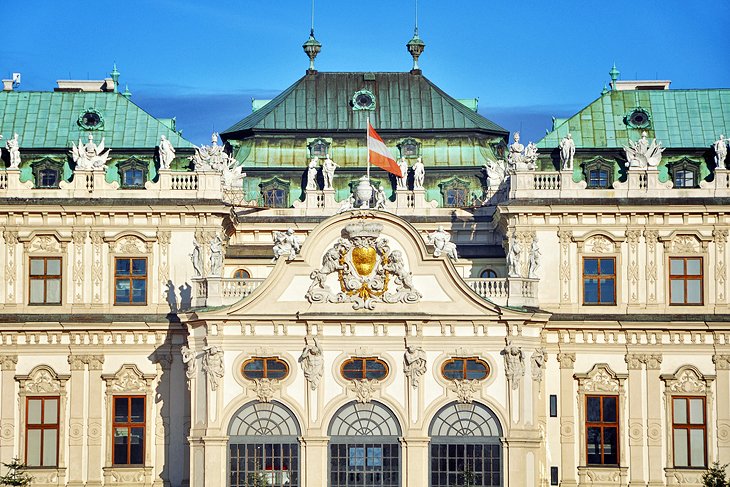
Home to the majority of the Belvedere Palace's vast art collection, this magnificent building is widely considered a piece of art in its own right. Highlights of a visit include seeing the Ground Floor Hall (Sala Terrena), with its statues of Atlas supporting the sumptuous stucco vaulted ceiling. You'll also see the adjoining Ceremonial Staircase, with its accompanying stucco relief and frescoes depicting the triumphs of Alexander the Great.
In the Carlone Hall is an impressive ceiling fresco, along with many rich furnishings. Be sure to take a peek at the elegant Marble Hall, too. This magnificent two-story hall is home to many fine period sculptures and paintings; of particular note is the superb ceiling fresco.
Address: Upper Belvedere, Prinz Eugen-Straße 27, 1030 Vienna, Austria
Lower Palace Highlights
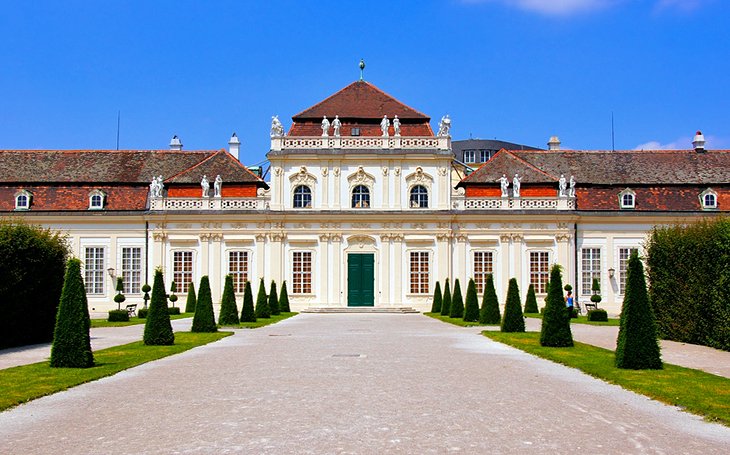
Built to serve as a residential palace, Belvedere's Lower Palace is no less impressive than the large Upper Palace. It, too, has a spectacular two-story Marble Hall designed as a place to welcome guests. Highlights of this large room are its oval-shaped plaster medallions depicting the god Apollo, and its rich ceiling fresco.
Also of note is the Marble Gallery, built exclusively to showcase a number of statues from antiquity along with collections of notable Baroque sculptures.
The Grotesque Hall - named after a style of art popular at the time - is also worth visiting for its finely preserved wall paintings. Other highlights include the superbly decorated Sale Terrene and the Garden Pavilion with its rich paintings and murals, as well as the Spitzhof, an outlying building set aside as an exhibition space.
The Orangery at Belvedere
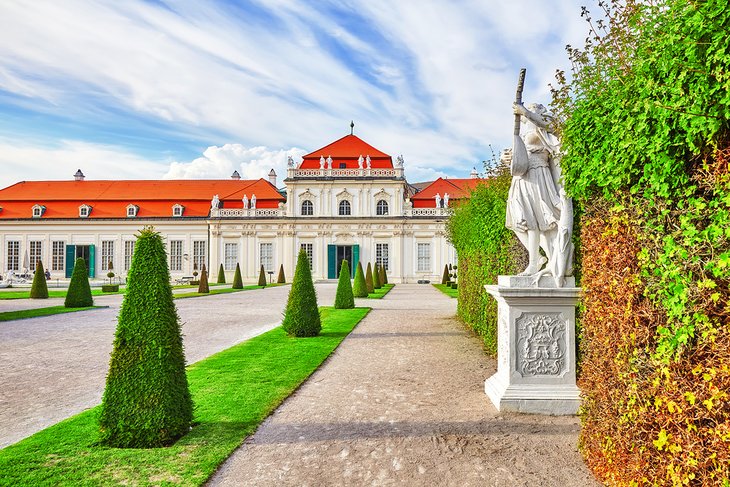
Originally a heated home for the palace's orange trees, the Belvedere Orangery (Orangerie) is unique in that it was designed so its roof and façade could be removed during the summer months.
Although a laborious process, it nevertheless avoided having to replant the trees each year. This beautiful structure today serves as a modern exhibition hall for art displays.
Editor's Note: Please be aware that the Orangery at Belvedere is closed to visitors due to major renovations until the end of 2021.
Address: Address: Rennweg 6, 1030 Vienna, Austria
The Palace Stables
Once used for Prince Eugene's horses, Belvedere's Palace Stables (Prunkstall) is a Baroque masterpiece and now houses an extensive collection of important medieval artwork.
Highlights include the Medieval Treasury with its panel paintings, sculptures, and Gothic triptychs. Free English language guides are available.
Editor's Note: Please note that the Palace Stables are closed to visitors due to major renovations until the end of 2021.
The Belvedere Gardens and Fountains
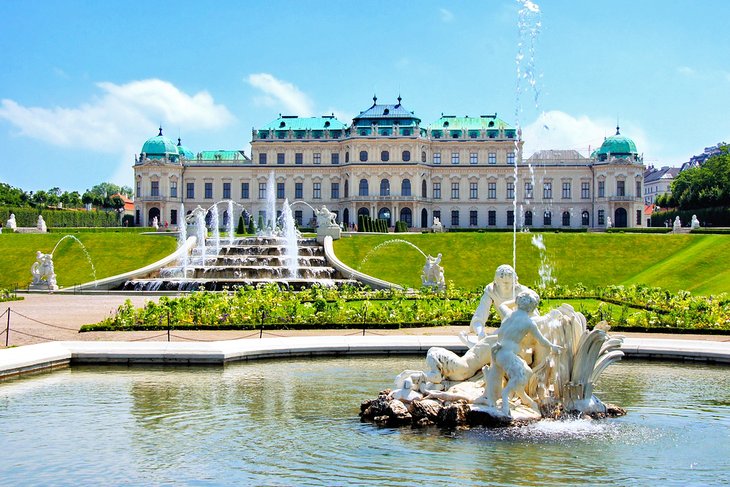
Linking the two palaces, the superb Belvedere Gardens contains numerous sculptures adorning its many pools. It was designed according to Hildebrandt's overall concept of a terraced park laid out along an axis with cascades and symmetrical flights of stairs bordered by hedges and paths.
At the foot of the gardens lies the Underworld with Pluto and Proserpina, along with Neptune and Thetis, the deities of water, in the area where the cascades play, together with Apollo and Hercules. From the terrace in front of Upper Belvedere are wonderful views over the garden and out over the Vienna Woods.
The Winter Palace of Prince Eugene
Although no longer open to the public - and not located in the Belvedere Palace complex itself - the Winter Palace of Prince Eugene (Winterpalais Prinz Eugen) is worth mentioning. You can still take a stroll past the palace - it's located in the Old Town area just off the bustling shopping area of Kärntner Straße.
The palace was originally designed to serve as a residence for Prince Eugene when he was in town. It also served for a spell as the Court Treasury. This splendid Baroque building, recently fully restored, also boasts a number of fine State Apartments that are open to the public.
Address: Himmelpfortgasse 8, 1010 Vienna
Art Galleries and Collections
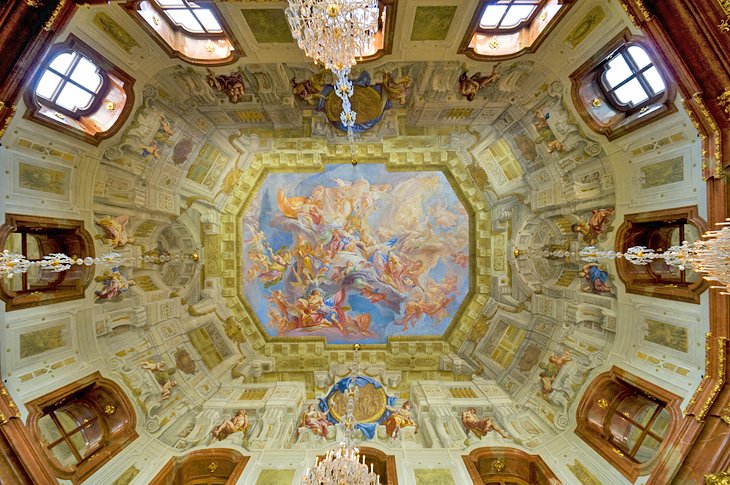
The vast majority of the Belvedere Palace's extensive art collections are housed in Upper Belvedere. Here, you'll find impressive collections of Austrian art dating from the Middle Ages to the present day set out in individual galleries. Perhaps the most important of these is Masterpieces from the Middle Ages, a rich collection of sculptures and panel paintings from the 12th century to the 16th century, including the Romanesque Stammerberg Crucifix, the oldest surviving example of Tyrolean wood carving.
Other highlights include four stone figures by the 14th-century Salzburg Master of Grosslobming; a Madonna and Child on a throne from the end of the 12th century; and outstanding exhibits of Crucifixion scenes, including the Wiltener Crucifixion.
Another exhibit focuses on Austrian Baroque artwork and boasts a large collection of paintings and sculptures from between 1683 and 1780. The most important pieces of Masterpieces of Baroque are to be found in the Rottmayr Room, dedicated to the work of Johann Michael Rottmayr. Often compared to the likes of Rubens, his work is famous for its bright, light colors and includes masterpieces such The Praising of the Name of Jesus and The Sacrifice of Iphigenia. In the Troger Gallery, works by Paul Troger including his masterpiece, Christ on the Mount of Olives, are displayed.
Other important collections include Austrian art of the 19th and 20th centuries, with works by Austrian greats such as Oskar Kokoschka and Oskar Laske, Herbert Boeckl, Josef Dubrowsky, and Rudolf Wacker. Among the postwar movements are Austrian Informel, the Viennese School of Fantastic Realism, and the New Painting of the Eighties. Impressionist works are represented by artists including Hans Makart, Claude Monet, and Vincent van Gogh, along with the world's largest collection of paintings by Austria's Gustav Klimt, including The Kiss.
Also of note are Upper Belvedere's fine collections of works by artists from the Classic and Romantic periods. Highlights include the historical, mythological, and religious themes seen in the works of Heinrich Füger, Johann Peter Krafft, and Leopold Kupelwieser, as well as landscapes by Ferdinand Georg Waldmüller, the master of the Viennese Biedermeier movement who became famous through his skills in handling light, as seen in his Great Prater Landscape.
Other landscapes are by Carl Blechen, Rudolf von Alt, Joseph Anton Koch, and Adalbert Stifter. Among the portrait painters represented are Friedrich Amerling, Johann Baptist Lampi the Elder, and Ferdinand Georg Waldmüller.
Finally, more modern works and collections, including an attractive sculpture garden, can be seen in the ultra-modern Belvedere 21 at the south end of the grounds.
Touring Belvedere Palace
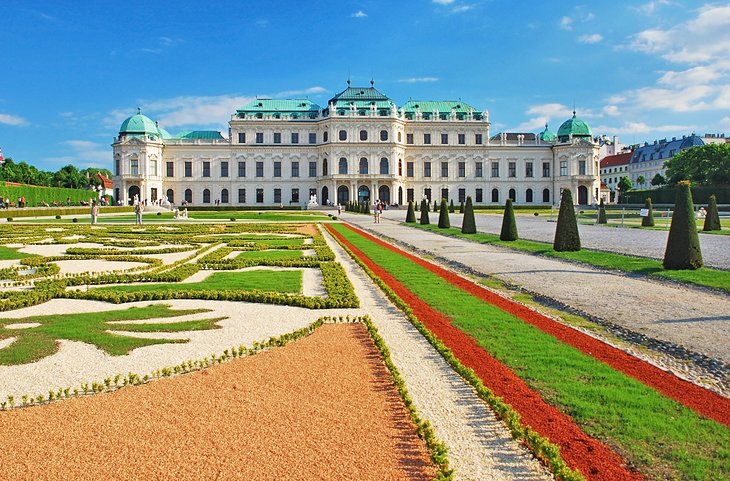
Hour-long English language guided tours are available. English language audio guides are also available for Upper Belvedere, as well as Lower Belvedere and the Orangery. Also of interest is the attraction's extensive educational programing, including longer themed tours and events focusing on a particular exhibit (available for both adults and children).
For a truly unique experience, art lovers can participate in Restoration and Conservation Workshops hosted in Lower Belvedere. Highlights include painting preservation and restoration, framing, paper and mounting workshops, as well as photographic workshops (contact Visitor Services for further information). Also of note is the opportunity to see public restorations of important works of art, held Tuesdays and Thursdays (10am-6pm) in Upper Belvedere.
Where to Stay near Vienna's Belvedere Palace
We recommend these highly rated hotels a short hop from Vienna's beautiful Belvedere Palace:
- Hotel Sacher Wien: Boasting 5-star luxury, ornate furnishings, and Belle Époque-inspired rooms, this posh hotel also features a boutique spa.
- Kaiserhof Wien: This 4-star hotel is set in a quiet location in a 19th-century building and boasts old-world charm, complimentary breakfast, a spa, and a steam room.
- Boutiquehotel Das Tyrol is a mid-range boutique hotel with artsy decor, a private sauna, and Nespresso machines.
- Ibis Wien City: This budget hotel is set in a great location and features contemporary styling.
Tips and Tactics: How to Make the Most of Your Visit to Belvedere Palace
- Dining: Upper Belvedere has a bistro, the Menagerie, offering snacks and light meals. The B-Lounge serves similar fair in Lower Belvedere. During summer, the small Café Garden provides light snacks with great views.
- Shopping: Three stores are available for souvenirs, books, and gifts (two in Upper Belvedere, one in Lower Belvedere). Online shopping is also available.
- Christmas Market: One of Vienna's most popular festive events, the Belvedere Christmas market takes place from the last week of November through Boxing Day. With the palace as a backdrop, it's the perfect spot for couples to get in some seasonal shopping.
- Access: Belvedere Palace is fully wheelchair accessible.
Getting to Belvedere Palace
- On Foot: Belvedere Palace is within walking distance of Vienna's city center and the majority of its main tourist attractions.
- By Bus: Belvedere Palace is well served by Vienna's bus services (Route 69A, stopping at Quartier Belvedere).
- By Tram: Vienna's superb tram services travel to Belvedere Palace regularly (Route D, stopping at Schloss Belvedere; Routes 18 and O stopping at Quartier Belvedere).
- By U-Bahn (Subway): The nearest subway station is Südtirolerplatz.
- By S-Bahn (Overground): The Palace is served by Station Quartier Belvedere.
- By Train: Vienna is well served by major rail routes from across Europe and Austria. The nearest station to Belvedere Palace, Station Quartier Belvedere, is only a few minutes' walk away.
- By Road: As with most major European cities, much of Vienna's city center is designated as pedestrians only. If driving is a must, park on the city's outskirts and use public transit.
- Parking: No on-site public parking is available.
Address
- Belvedere Palace - Prinz Eugen Strasse 27, 1030 Vienna, Austria
- www.belvedere.at/en
Vienna - Climate Chart
| Average minimum and maximum temperatures for Vienna, Austria in °C | |||||||||||
| J | F | M | A | M | J | J | A | S | O | N | D |
| 2 -3 | 4 -2 | 9 2 | 14 5 | 19 9 | 22 13 | 25 15 | 25 15 | 21 12 | 14 6 | 7 2 | 4 -1 |
| PlanetWare.com | |||||||||||
| Average monthly precipitation totals for Vienna, Austria in mm. | |||||||||||
| 38 | 43 | 41 | 51 | 61 | 74 | 64 | 58 | 46 | 41 | 51 | 43 |
| Average minimum and maximum temperatures for Vienna, Austria in °F | |||||||||||
| J | F | M | A | M | J | J | A | S | O | N | D |
| 36 27 | 39 28 | 49 35 | 57 41 | 67 49 | 72 55 | 77 59 | 77 59 | 69 53 | 57 43 | 44 35 | 39 30 |
| PlanetWare.com | |||||||||||
| Average monthly precipitation totals for Vienna, Austria in inches. | |||||||||||
| 1.5 | 1.7 | 1.6 | 2.0 | 2.4 | 2.9 | 2.5 | 2.3 | 1.8 | 1.6 | 2.0 | 1.7 |
What's Nearby?
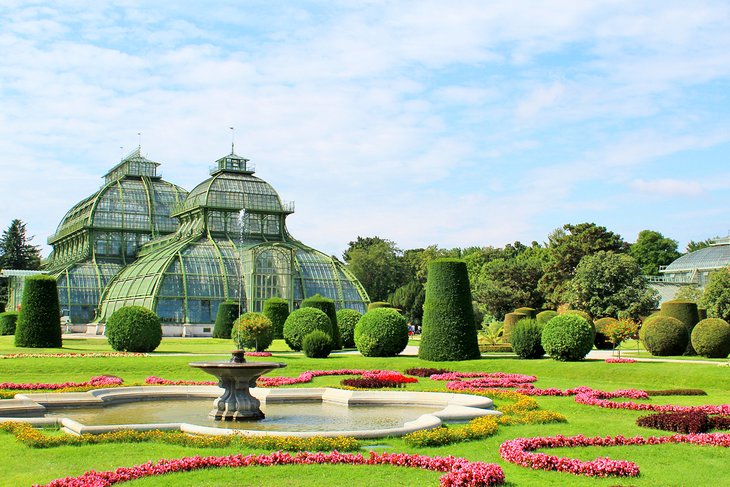
Given its central location, Belvedere Palace is close to numerous other popular attractions in Vienna. Among the closest gardens and parks are the lovely Botanical Gardens of the University of Vienna, the Alpengarten, and the Schweizergarten, all great locations for a little relaxation or a picnic after a busy day at the galleries and museums.
For art lovers, a number of excellent collections can be seen at the Austrian Gallery (Osterreichische Galerie) with its 19th- and 20th-century art, along with displays of Baroque and medieval masterpieces. Also of interest is the Museum of Military History (Heeresgeschichtliches Museum) to the south of the Belvedere, home to numerous historical artifacts, including Archduke Ferdinand's car, in which he and his wife were riding when assassinated in 1914.


